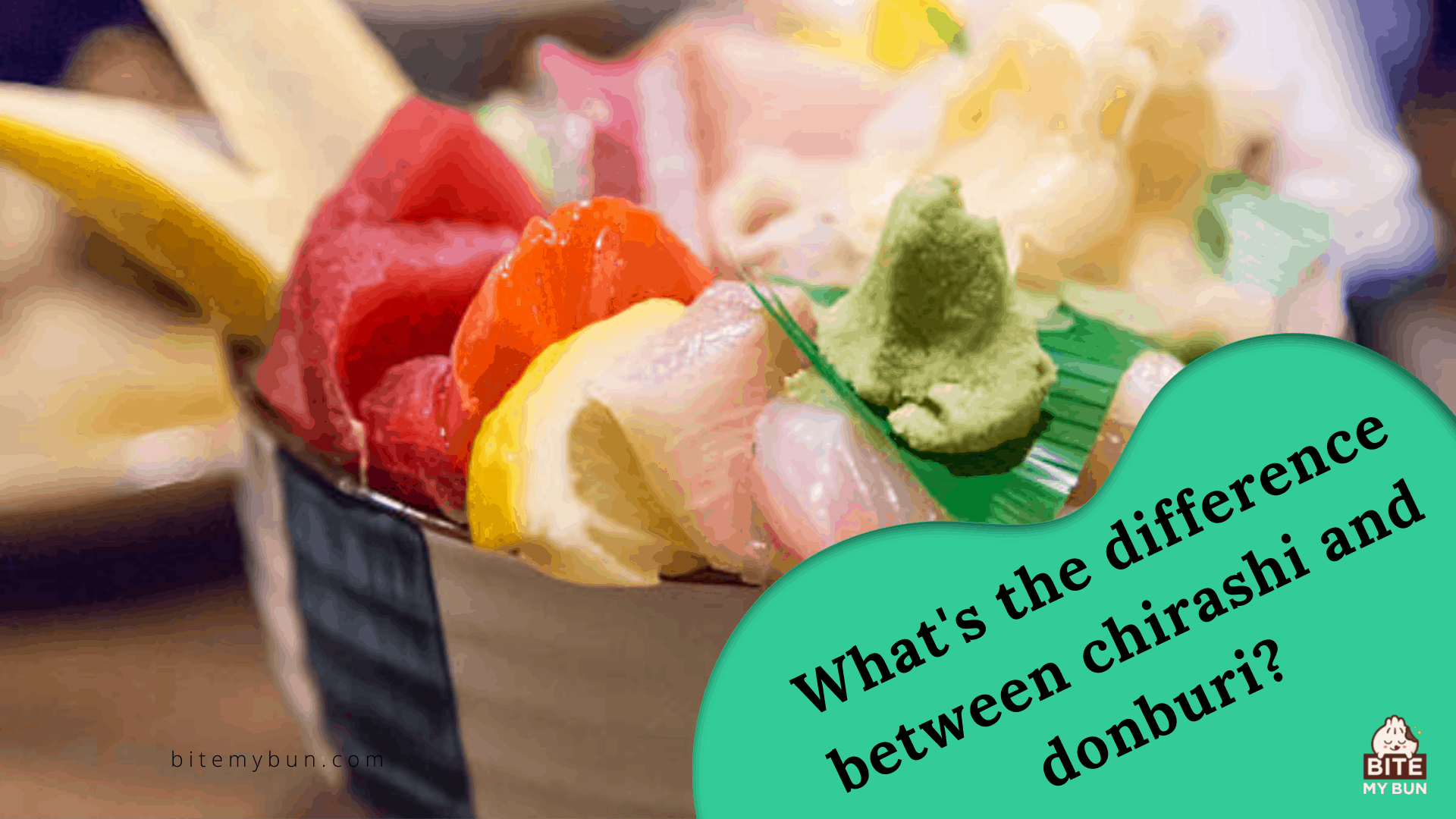What’s the difference between chirashi and donburi?
Chirashi (Chirashizushi) is a sushi dish, that is usually referred to as the “scattered sushi” dish. It is usually eaten during festive occasions in Japan.
People sometimes confuse it with donburi, which is a Japanese dish served in a bowl.

Their most basic difference is that chirashi is more of a “festivity” food when donburi is very traditional.

Check out our new cookbook
Bitemybun's family recipes with complete meal planner and recipe guide.
Try it out for free with Kindle Unlimited:
Read for freeIn this post we'll cover:
Chirashi explained
Chirashizushi ( it is sometimes called Barazushi as well), is actually a plain and filling dish that can be eaten any time of the year. Nevertheless, people eat it more during Hinamatsuri (March) and Kodomonohi (May).
As mentioned above, it is known as the “festive” and “happy” dish people go for, when they throw a party or celebrate, in general.
As a matter of fact, there are some variations of this sushi dish (some more formal). These 3 variations have a different preparation processes.
Edomae chirashizushi
Firstly, we have Edomae chirashizushi. It is probably the most popular variety.
It is served in most restaurants in and outside of Japan. Sushi chefs started creating this dish during the 1990s.
When it comes to its style, we have a layer of vinegared rice, and on top of it (usually) a variety of uncooked toppings that result in a very artistic dish.
Gomokuzushi
Secondly, we have Gomokuzushi. It is also known as Kansai-style sushi. It resembles Edomae Chirashizushi, but it has some differences.
First of all, the toppings we usually see in this dish are fish, meat, and vegetables (both cooked & uncooked toppings).
In addition, this dish differs from region to region, as it includes Japanese toppings that are very unique.
Some of these are:
- kanpyo
- gobo
- lotus root (easy to find in Japan, harder to find abroad).
Also, the toppings can be found in the body of the rice as well.
Kyushu-style sushi or Sake-zushi
Thirdly, we have Kyushu-style sushi (also known as Sake-zushi). This dish is cooked with rice and wine or sake, instead of vinegar.
Also, the toppings used in this dish usually are vegetables and fish, and more rarely meat or eggs.
Donburi explained
The name donburi is actually broken down into two names, one for the bowl and one for the actual food.
This meal is served in a special rice bowl, which is called donburi-bachi. The food is called donburi-mono.
It is interesting how many dishes and recipes can be adapted in the donburi style. Have a look at this TenDon “Tempura Donburi” recipe for example.
This style of meal is usually preferred for lunch, as these meals are served in large bowls.
Donburi includes plain rice and toppings such as meat (like beef in gyudon), fish, and vegetables cooked on low heat.
Also, any kind of leftover can be used as a topping for this dish, which is why this meal is very easy to prepare.
In addition, donburi is also known to be a stew that is added on top of the rice. Savory and sweet stews can be added.
Therefore, as many regions have different toppings and ingredients, this meal is very adaptable and it is highly affected by Japanese local delicacies.
Nevertheless, this dish has its signature sauce, which consists of dashi. Dashi is a special broth that might also contain rice wine and soy sauce.
Donburi dishes
As mentioned above, donburi is more of a traditional style of dish. Therefore, there are some dishes that show the donburi character.
Some of these dishes are the following:
- Butadon: it is a prok-based dish, with a sweet sauce. Stems from Hokkaido.
- Tentamadon: it has shrimp tempura and eggs.
- Unadon: (the “eel bowl”) follows the donburi style but mainly has eel as the dominant topping. The eel is cooked in the kabayaki style ( caramelized).
- Katsudon: it consists of beaten eggs, pork cutlets, and onion. It varies from region to region in Japan.
- Sōsukatsudon: It has cabbage and sweet-salty sauce.
- Karēdon: it has curry-flavored dashi.
- Tekkadon: it has raw tuna, and it is usually cooked with many spices, resulting in a very unique spicy flavor.
- Hokkaidon: it consists of raw salmon.
- Negitorodon: it has diced tuna and spring onions.
- Ikuradon: it is basically seasoned salmon roe, on rice.
- Tenshindon or Tenshin-han: it consists of a crab-meat omelet, on a layer of rice. This meal also includes both Chinese and Japanese elements, and it is named after the city of Tianjin.
Conlusion
Taking everything into account, the basic differences between chirashi and donburi are their preparation, overall character (informal versus festive), and amount of varieties.
In addition, chirashi is more of a dish, when donburi is a style. Also, chirashi consists of rice cooked with vinegar, when donburi consists of plain rice.
Even though chirashi and donburi are very different, they are both very interesting, delicious, and inclusive of many Japanese elements.
Chirashi is a very good lunch suggestion for a special event, and donburi can be made into many varieties, with many tasty ingredients (meat, fish, vegetables, and eggs!).
Here’s another easy Japanese rice dish that’s perfect for special events: Yaki onigiri (recipe here)
Check out our new cookbook
Bitemybun's family recipes with complete meal planner and recipe guide.
Try it out for free with Kindle Unlimited:
Read for freeJoost Nusselder, the founder of Bite My Bun is a content marketer, dad and loves trying out new food with Japanese food at the heart of his passion, and together with his team he's been creating in-depth blog articles since 2016 to help loyal readers with recipes and cooking tips.

